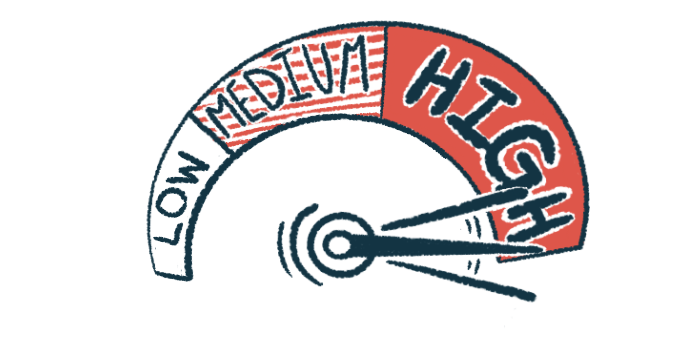Fat deposits around heart increase risk of heart disease in Cushing’s
Reducing fat accumulation may help mitigate risk, per new study
Written by |

A higher volume of epicardial adipose tissue (EAT) — meaning more fat accumulated near the heart muscle and arteries that supply the heart — significantly increases the risk for early heart disease in people with Cushing’s syndrome.
That’s according to a study from China that assessed risk factors for left ventricular diastolic dysfunction, or LVDD, a condition that affects the ability of the heart’s left ventricle, or chamber, to fill with blood before contraction.
“These results suggested that reducing EAT accumulation may be promising to mitigate the risk of LVDD development in patients with [Cushing’s syndrome],” the researchers wrote.
The study, “Epicardial adipose tissue volume highly correlates with left ventricular diastolic dysfunction in endogenous Cushing’s syndrome,” was published in Annals of Medicine.
Higher risk of heart disease seen for patients vs. healthy people
Cushing’s syndrome comprises a group of conditions characterized by high levels of the stress hormone cortisol, produced by the adrenal glands, located atop the kidneys.
Cushing’s disease, the most common form of the syndrome, is caused by a tumor in the brain’s pituitary gland, which produces excessive levels of ACTH, a hormone that triggers cortisol production.
The syndrome is associated with several risk factors of cardiovascular disease, including diabetes, marked by high levels of blood sugar, high blood pressure, also known as hypertension, and dysregulation of the levels of fatty molecules in the blood. Cardiovascular complications are the main cause of death in this patient population.
Additionally, evidence suggests that exposure to excessive levels of cortisol may cause changes in the heart’s structure and function, and increase the risk of heart failure.
Now, a team of researchers from Tongji Medical College at Huazhong University of Science and Technology set out to evaluate the potential impact of high cortisol levels on certain types of body fat, including EAT. The team also sought to identify risk factors for LVDD, an underlying mechanism associated with heart failure, in people with Cushing’s syndrome.
The researchers retrospectively analyzed data from 86 adults with endogenous Cushing’s, and 86 healthy people matched for age, sex, and body mass index (BMI), a ratio of height and weight (used as the control group).
Cushing’s disease was the most common form of the syndrome, accounting for the diagnosis of 48 patients (55.8%).
Compared with the control group, the individuals with Cushing’s had significantly higher cardiovascular risk factors, including higher blood pressure, higher blood sugar levels, and more severe problems with fat metabolism. Also, a significantly higher proportion of these patients had hypertension (74.42% vs. 6.98%) and diabetes (48.84% vs. 2.33%) relative to the controls.
Moreover, Cushing’s patients had significantly higher EAT volume (150.3 vs. 90.6 cubic centimeters) and area of visceral fat, or the fat that accumulates around abdominal organs (166.81 vs. 80.28 cubic centimeters). There also were significant differences regarding heart structure and function parameters between the two groups.
More study needed into impact of excess corisol on fat deposits
A total of 50 patients (58.1%) had LVDD, while the remaining 36 (41.9%) did not. Those with LVDD were significantly older, had significantly higher EAT volume (175.28 vs. 142.16 cm3) and visceral fat area (194.06 vs 152.14 cm2), and a significantly lower E/A ratio, a measure of left ventricle function.
Moreover, EAT volume was significantly higher in patients with ACTH-dependent Cushing’s (173.6 vs. 129.91 cm3), as well as visceral fat (188.7 vs. 145.2 cm2), compared with those with ACTH-independent Cushing’s.
Statistical analyses adjusted for potential influencing factors showed that a higher EAT volume was significantly and independently associated with an increased risk for LVDD.
In turn, higher blood levels of HDL-C — known as so-called good cholesterol — and higher estimated glomerular filtration rate, indicating better kidney function, were protective factors against LVDD.
Using a cutoff value of 139.252 cubic centimeters, EAT volume was able to discriminate Cushing’s patients with LVDD with a sensitivity of 84% sensitivity and a specificity of 55.6%. A test’s sensitivity is its ability to correctly identify those with a given disease, while specificity refers to correctly identifying those without it.
Overall, “these results underscored the potentially pivotal role of excessive cortisol-induced EAT deposition in the development of LVDD in [Cushing’s syndrome] patients,” the researchers wrote.
“Future studies with larger sample sizes are required to validate our results and explore the impact of excess cortisol on EAT deposition, as well as identify additional risk factors for the development of LVDD in [Cushing’s],” the team concluded.







